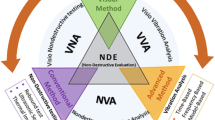Abstract
The objective of this paper is to investigate the feasibility of wireless sensors in the development of an autonomous structural health monitoring system. A collaborative searching algorithm is developed such that massively deployed wireless sensor nodes in a structure conveniently comprise a group and constitute a damage-surveillance perimeter. Wireless sensors in this perimeter spontaneously activate themselves for damage-tracking tasks by networking with neighboring sensors. When the damage-sensitive parameter that is measured by a sensor node exceeds a certain threshold, the process of damage-tracking begins. The proposed damage-tracking algorithm does not require any type of global control. Instead, sensor-networking and a pairwise-comparison algorithm that is implemented at each sensor node allows collaborative decision-making for tracking the changes, such as local strain, in structural properties. The extant autonomous, damage-tracking algorithms have been demonstrated through only numerical simulations for a single-damage case. Here, the study is further expanded to address the problem of simultaneously tracking multiple instances of damage in three-dimensional space by using improved algorithms for sensor networking. An event-based task-executing functionality of individual sensor nodes is successfully implemented and verified using four wireless strain sensors that are mounted on a cantilevered beam structure. Experimental results reveal that the overall capability of wireless sensor nodes is functional enough to enable a wireless-based autonomous structural health monitoring system.
Similar content being viewed by others
References
Sohn, H., Farrar, C. R., Hemez, F. M., Shunk, D. D., Stinemates, D. W. and Nadler, B. R., “A review of structural health monitoring literature: 1996–2001,” Los Alamos National Laboratory, Technical Reports LA-13976-MS, 2003.
Glaser, S. D., “Some real-world applications of wireless sensor nodes,” SPIE Symposium on Smart Structures & Materials: NDE 2004, 2004.
Akyildiz, I. F., Su, W., Sankarasubramaniam, Y. and Cayirci, E., “Wireless sensor networks: a survey,” Computer Networks, Vol. 38, No. 4, pp. 393–422, 2002.
Lynch, J. P., “Overview of wireless sensors for real-time health monitoring of civil structures,” Proc. of the 4th International Workshop on Structural Control and Monitoring, pp. 189–194, 2004.
Kottapalli, V. A., Kiremidjian, A. S., Lynch, J. P., Carryer, E., Kenny, T. W., Law, K. H. and Lei, Y., “Two-tiered wireless sensor network architecture for structural health monitoring,” SPIE’s 10th Annual International Symposium on Smart Structures & Materials, Vol. 5057, pp. 8–19, 2003.
Yuan, S., Lai, X., Zhao, X., Xu, X. and Zhang, L., “Distributed structural health monitoring system based on smart wireless sensor and multi-agent technology,” Smart Materials and Structures, Vol. 15, No. 1, pp. 1–8, 2006.
Lynch, J. P., Wang, Y., Sundararjan, A., Law, K. H. and Kiremidjian, A. S., “Wireless sensing for structural health monitoring of civil structures,” Proc. of International Workshop on Integrated Life-Cycle Management of Infrastructures, 2004.
Xu, N., Rangwala, S., Chintalapudi, K. K., Ganesan, D., Broad, A. and Estrin, D., “A wireless sensor network for structural health monitoring,” Proc. of the 2nd ACM Conference on Embedded Networked Sensor Systems, pp. 13–24, 2004.
Pakzad, S. N. and Fenves, G. L., “Structural health monitoring applications using MEMS sensor networks,” Proc. of the 4th International Workshop on Structural Control, pp. 47–56, 2004.
Caffrey, J., Govindan, R., Johnson, E. A., Krishnamachari, B., Masri, S., Sukhatme, G., Chintalapudi, K. K., Dantu, K., Rangwala, S., Sridharan, A., Xu, N. and Zuniga, M., “Networked sensing for structural health monitoring,” Proc. of the 4th International Workshop on Structural Control, pp. 57–66, 2004.
Clayton, E. H., Koh, B. H., Xing, G., Fok, L., Dyke, S. J. and Lu, C., “Damage detection and correlation-based localisation using wireless sensor mote sensors,” Proc. of the 13th Mediterranean Conference on Control and Automation, pp. 304–309, 2005.
Jeong, M. J. and Koh, B. H., “A decentralized approach to damage localization through smart wireless sensors,” Smart Structures and Systems, Vol. 5, No. 1, pp. 43–54, 2009.
HyBus Co. Ltd., “Hmote-ZigBee based wireless sensor network system (IEEE802.15.4)”.
Author information
Authors and Affiliations
Corresponding author
Rights and permissions
About this article
Cite this article
Jeong, M., Bae, JG. & Koh, BH. A feasibility study of damage tracking through the diffusive communication of wireless sensors. Int. J. Precis. Eng. Manuf. 11, 23–29 (2010). https://doi.org/10.1007/s12541-010-0003-6
Received:
Accepted:
Published:
Issue Date:
DOI: https://doi.org/10.1007/s12541-010-0003-6




